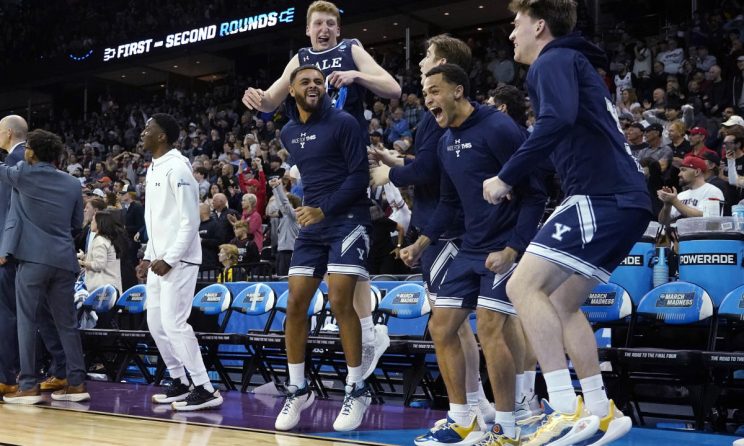
Kevin Keatts and North Carolina State reached the NCAA Tournament the old-fashioned way.
The way that existed before the bubble. Before bracketology. Before NET rankings, KenPom, the transfer portal, name, image and likeness and all the rest. Before the tournament field grew (and grew some more), when the only way to punch your ticket into March Madness was by winning your conference tournament.
N.C. State earned the Atlantic Coast Conference’s automatic bid by ripping off five victories in five days to capture the conference tournament title. The 11th-seeded Wolfpack pushed their postseason winning streak to seven and are now in the Sweet 16 for the first time in nearly a decade.
It’s been a thrilling if exhausting ride, the kind of run that saves jobs. It has also done little to alter Keatts’ view about whether the tournament should expand beyond its current 68-team format:
In an era where more than half the 133 Division I football programs qualify for a bowl game (while acknoledging this is not the purview of the NCAA), forcing 80% of the 350-plus Division I basketball schools to watch March Madness from their dorms seems outdated and unnecessarily punitive.
“We talk about the student-athlete experience, and the only thing that really, in my opinion, that has not changed is expanding the tournament,” Keatts said. “And I don’t have a number. I don’t know what that should be. But I do think we should give more schools opportunities to be able to get in the tournament.”
Keatts is hardly alone. The chorus for expansion is growing ever louder.
MORE TEAMS, MORE PROBLEMS?
The NCAA committee has discussed all of this at length in the wake of the organization’s transformation committee suggesting that NCAA-sanctioned championships in larger sports be open to a quarter of the teams participating in it.
In Division I men’s basketball, that breaks down to around an 88-team field, which would make for an unwieldy option to the (nearly) perfect 68-school bracket that’s been an office pool staple the morning after Selection Sunday since 2011.
Going that large seems unlikely. CBS and Warner Brothers Discovery have no interest in moving the Final Four past its current end day the first weekend in April. And beginning the tournament earlier to accommodate massive expansion would cause a ripple effect that would force the regular season to start even earlier at a time when attention is focused squarely on football in most places.
While Big East Commissioner Val Ackerman believes most of her colleagues are more open to a “modest” bump to 72 or 76 teams, the real sticking point is over money and access.
The NCAA’s $8.8 billion TV contract runs through 2032 and will not change regardless of the field size. Though adding more games would provide a small boost through ticket sales and merchandise, the reality is the pool of money the NCAA uses to pay out conferences and member schools would essentially stay the same whether the field expands or not.
What could change, however, is how that money would be divided up if the tournament broadens.
Every team that reaches the NCAA Tournament currently receives the same amount of revenue (called a “ unit ” in NCAA parlance) for making the tournament. The longer a school’s tournament run — through the regional final anyway — the more units the school’s conference receives.
For leagues that typically garner one or two bids, the windfall can make a serious impact. Loyola Chicago’s memorable run to the Final Four in 2018 gave the Missouri Valley Conference a significant boost.
What could shift if the field expands is how those units are allotted. One option could be to weigh the units, meaning having them grow exponentially through each round, thereby decreasing the value of simply making the field.
It’s a setup that could further exacerbate the already widening fiscal gap between super-sized conferences like the Big Ten and SEC and everyone else.
Ackerman stressed “none of us would like to see our unit value diminish,” and that the Big East — which had three teams advance to the Sweet 16 — would have a “point of view if it was going to be undercut in any way.”
Atlantic 10 Commissioner Bernadette McGlade, who spent 10 years on the men’s tournament selection committee, has become a strong advocate for expansion if it’s done the right way. That means not predicating expansion on the idea that the extra 4-8 at-large bids automatically go to mid-tier schools from a power conference.
“I do think the (NCAA) has to keep the (big conferences’) feet to the fire to maintain some semblance of fairness for the student-athletes,” she said. “They can’t just keep taking more and more and more.”
And therein lies an issue harder to define: Who and what is March Madness designed for?
“WE’RE WHAT MAKE THIS TOURNAMENT”
The most memorable moments from the opening weekend weren’t the chalky blowouts but Yale’s stunner over Auburn, Oakland taking down the bluest of bluebloods in an electrifying upset of Kentucky and the Middle Tennessee State women knocking off Louisville before giving Angel Reese and LSU all it could handle before falling in the second round.
“We’ve got a pretty good game here,” MTSU coach Rick Insell said. “You’ve got some of those automatic qualifiers putting some of those (at-large) teams out that really probably shouldn’t have been in the NCAA Tournament, to be honest with you.”
Oakland coach Greg Kampe, who will begin his 41st season with the Golden Grizzlies next fall, is actually against expansion even though Oakland competes in the Horizon League, which hasn’t received multiple NCAA bids since 2009. Still, he understands the landscape is changing. Kampe is hopeful amid all this change that the powers that be won’t forget what — or more importantly who — brings the madness to March.
“We’re what make this tournament,” Kampe said, “the little guy.”
Zoom out, however, and bigger has always seemed to be better for the NCAAs. What started as an eight-team curiosity in Philadelphia, San Francisco and Chicago in 1939 has mushroomed to a 68-team behemoth spread across the country that stakes its claim to an entire month on the sports calendar.
TV ratings for the opening two rounds to the 2024 edition were the highest in five years. The presence of programs like North Carolina, Duke and defending national champion UConn in the Sweet 16 likely means interest figures only to spike as the tournament barrels toward the Final Four.
No matter how big the tournament gets, there will always be some schools left on the outside looking in.
Pitt forward Blake Hinson would know. Six days after calling the current tournament size “perfect,” Hinson and the Panthers — who finished fourth in the ACC during the regular season — saw their bubble burst when the Wolfpack ran off with the tournament title.
“You know, some people get missed,” Hinson said before the 22-win Panthers were left out. “And that’s part of it.”
That part of the process will never change. The question for the NCAA going forward is how to find the right balance between who gets in and who doesn’t, an increasingly thorny proposition.
“I think this thing is so great and so big, I think cooler heads will prevail and will do everything and anything to keep this thing as close as we can to what makes it special,” Gonzaga coach Mark Few said. “If we have to make some tweaks, we have to make some tweaks.”
To survive and advance in a sport where the tectonic plates are in perpetual shift, the tournament may have no choice.
___
AP National Writer Eddie Pells, AP College Sports Writer Ralph Russo and AP Sports Writer Stephen Whyno contributed to this report.
___
AP March Madness bracket: https://apnews.com/hub/ncaa-mens-bracket and coverage: https://apnews.com/hub/march-madness






